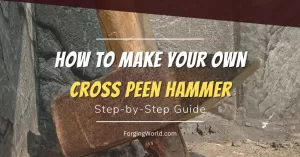Are you ready to embark on an exciting journey into the world of copper forging? Copper is a fantastic material for beginners—it’s versatile, beautiful, and easier to work with compared to other metals.
In this article, we’ll explore five beginner-friendly copper projects that will help you develop essential forging skills.
Before we dive into the projects, make sure you’re well-versed in the basics of copper forging. Our comprehensive guide on how to forge copper is a great starting point. Additionally, read about forging copper vs. other metals to understand copper’s unique properties and advantages.
Now, let’s dive into these fantastic beginner-friendly copper projects!
1. Copper Bracelets: Craft Stunning Wearable Art
Creating copper bracelets is a perfect way to get started with copper forging. The process is simple and requires minimal tools.
You’ll learn essential techniques like hammering, shaping, and finishing, while creating a beautiful piece of wearable art. Plus, the end result makes for a stunning piece of wearable art.
What you’ll need:
- Copper sheet or strip
- Hammer
- Anvil or metal block
- Pliers
- Files
- Sandpaper
Steps to forge a copper bracelet:
- Cut a copper strip to your desired width and length.
- Heat the copper strip in your forge until it’s soft and malleable.
- Hammer the strip into your desired shape, tapering the ends if necessary.
- Use pliers to create curves and bends for a more intricate design.
- File the edges to remove any burrs or sharp points.
- Sand the bracelet to achieve a smooth finish.
For more inspiration and tips, check out our forging copper jewelry ideas.
2. Copper Hooks: Practical and Attractive Home Décor
Crafting copper hooks is another excellent project for beginners. They’re practical, attractive, and an attractive addition to any home.
This project will help you practice your hammering, bending, and hole-punching techniques.
What you’ll need:
- Copper rod or bar
- Hammer
- Anvil or metal block
- Pliers
- Punch and chisel
- Drill (optional)
Steps to forge a copper hook:
- Cut a copper rod or bar to your desired length.
- Heat one end in your forge, then flatten it using your hammer and anvil.
- Bend the flattened end into a hook shape using your pliers.
- Punch a hole near the other end for mounting. Alternatively, you can drill the hole after the copper has cooled.
- Heat treat the hook to harden it, then polish the surface for a smooth finish.
Our beginner copper forging projects guide offers more detailed instructions and ideas.
3. Copper Garden Tools: Bring Beauty and Function to Your Garden
Once you’ve got the hang of basic hammering and shaping techniques, why not create a set of custom copper garden tools?
Copper has natural antimicrobial properties, which make it perfect for gardening tools like trowels and cultivators.
What you’ll need:
- Copper sheet or plate
- Hammer
- Anvil or metal block
- Metal shears or saw
- Files
- Sandpaper
- Wooden dowel or handle material
Steps to forge copper garden tools:
- Draw your desired tool shape on a copper sheet or plate, then cut it out using metal shears or a saw.
- Heat the copper piece in your forge until it’s malleable.
- Hammer and shape the tool using your anvil and hammer, creating the desired curves and edges.
- File and sand the edges to remove any burrs and ensure a smooth finish.
- Heat treat the tool to harden it, then polish the surface for an attractive appearance.
- Attach a wooden dowel or other handle material to your copper tool using epoxy, rivets, or screws.
For more guidance and inspiration, visit our forge copper tools gardening guide.
4. Copper Patina Art: Add Stunning Colors and Finishes to Your Creations
After you’ve mastered basic copper forging, it’s time to explore the world of copper patinas!
Adding patina to your copper projects can create stunning colors and finishes that’ll truly make your work stand out.
What you’ll need:
- Copper piece (forged or store-bought)
- Patina solution (store-bought or homemade)
- Brush or sponge
- Gloves
- Safety goggles
- Clear sealant
Steps to add patina to copper:
- Clean the copper piece to remove any dirt or grease.
- Apply the patina solution to the copper surface using a brush or sponge.
- Allow the solution to react with the copper, creating the desired patina effect. This may take several minutes to a few hours, depending on the solution and desired result.
- Rinse the copper piece thoroughly to stop the reaction.
- Dry the piece and apply a clear sealant to protect the patina.
Experiment with various patina techniques using our comprehensive how-to copper patinas guide.
5. Copper Bottle Opener: Challenge Yourself with a Functional and Stylish Project
Once you’re more comfortable with copper, why not challenge yourself to create a practical and unique bottle opener? It’s a fantastic way to practice your skills while creating something functional and stylish.
What you’ll need:
- Copper rod or bar
- Hammer
- Anvil or metal block
- Pliers
- Files
- Sandpaper
Steps to forge a copper bottle opener:
- Cut a copper rod or bar to your desired length.
- Heat one end in your forge, then flatten and shape it into a “U” or “V” to form the bottle-opening mechanism.
- Create any additional bends or twists in the design using your pliers.
- File and sand the edges to remove burrs and ensure a smooth finish.
- Heat treat the bottle opener to harden it, then polish the surface for a beautiful appearance.
To avoid common pitfalls and ensure a successful project, refer to our copper forging mistakes article.
Final Thoughts
And there you have it—five beginner-friendly copper projects to help you dive into the world of blacksmithing and bladesmithing!
Remember, practice makes perfect, so don’t be afraid to experiment and make mistakes. Keep learning and refining your skills, and soon you’ll be a copper forging pro.


